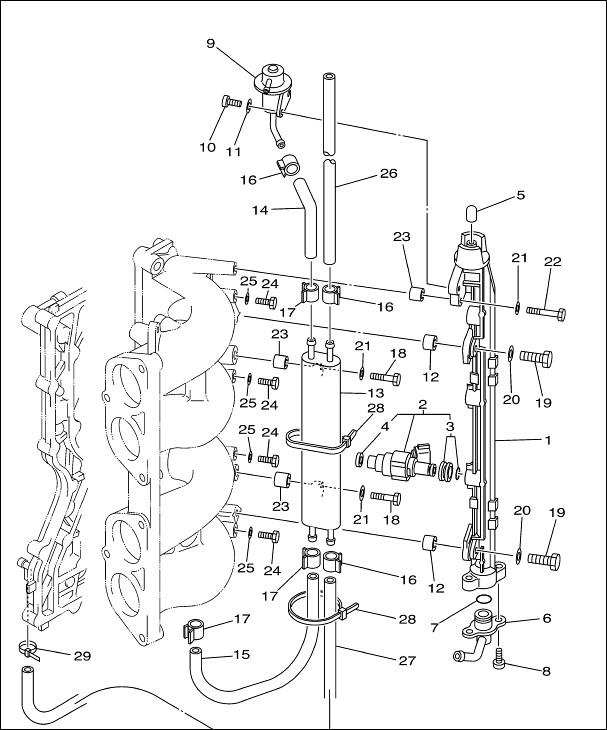Hey all -
Last year I bought my sister's old deck boat. It had been maintained perfectly by the original owner, but she had some health issues and had let it sit for 2 years.
It didn't take too much to get back on the water- I redid all the normal maintenance things, filters, etc. I had a hard time getting it past 3000 rpm for a month or 2, but some reading on the forum led to the VSP. It was fairly oxidized inside, nice and chalky, and the filter was clogged. I cleaned it up with some copper brushes, new filter, cleaned out the injectors and she ran like new.
A week later my friend borrowed it for his boyscout troop island campout and sank it. Ahem...buy me a beer and I'll tell you all about it.
Some better friends and I had her up and home 6 hours later, and I go through every engine saving strategy I can find. It had gotten wet in the hood (top part didn't go all the way under, but close) and there was salt water in the inline filter. Drain all the gas, drain the VST, replace all the filters... It all pays off - she starts perfect and still runs like a champ with one problem-
After about 30 minutes (sometimes longer, sometimes sooner) the top RPMs stop dropping, until I am crawling back down the channel at 1900 RPM. It's always the VST filter. I have a 10 micron filter on the firewall, and new filter inside the hood (clamp on inline instead of the original yamaha), and the gas looks pristine. I have sprayed out the fuel manifold and changed all the lines. It has happened 4 times now-
The VST filter is always clogged with a white powder. Inside the VST it looks chalky, and there is some corrosion on the surface of the pump inside. I have tried a handful of things- I've used scotchbrite, copper brushes, and steel wool on the pump and the inside of the VST. Once I even filled the bottom half of the tank with vinegar, hoping that the mild acid would exorcize my demons. Nothing seems to help for very long - I go for a test run, it works great, then less great, then barely there at all.
Any advice? It seems that other folks with VST issues seem to have tracked it down to ethanol, so I may be on the wrong track. I started getting her ready for service again, and I would love to finally put and end to this particular problem.
Thanks for your advice!
-rj
Last year I bought my sister's old deck boat. It had been maintained perfectly by the original owner, but she had some health issues and had let it sit for 2 years.
It didn't take too much to get back on the water- I redid all the normal maintenance things, filters, etc. I had a hard time getting it past 3000 rpm for a month or 2, but some reading on the forum led to the VSP. It was fairly oxidized inside, nice and chalky, and the filter was clogged. I cleaned it up with some copper brushes, new filter, cleaned out the injectors and she ran like new.
A week later my friend borrowed it for his boyscout troop island campout and sank it. Ahem...buy me a beer and I'll tell you all about it.
Some better friends and I had her up and home 6 hours later, and I go through every engine saving strategy I can find. It had gotten wet in the hood (top part didn't go all the way under, but close) and there was salt water in the inline filter. Drain all the gas, drain the VST, replace all the filters... It all pays off - she starts perfect and still runs like a champ with one problem-
After about 30 minutes (sometimes longer, sometimes sooner) the top RPMs stop dropping, until I am crawling back down the channel at 1900 RPM. It's always the VST filter. I have a 10 micron filter on the firewall, and new filter inside the hood (clamp on inline instead of the original yamaha), and the gas looks pristine. I have sprayed out the fuel manifold and changed all the lines. It has happened 4 times now-
The VST filter is always clogged with a white powder. Inside the VST it looks chalky, and there is some corrosion on the surface of the pump inside. I have tried a handful of things- I've used scotchbrite, copper brushes, and steel wool on the pump and the inside of the VST. Once I even filled the bottom half of the tank with vinegar, hoping that the mild acid would exorcize my demons. Nothing seems to help for very long - I go for a test run, it works great, then less great, then barely there at all.
Any advice? It seems that other folks with VST issues seem to have tracked it down to ethanol, so I may be on the wrong track. I started getting her ready for service again, and I would love to finally put and end to this particular problem.
Thanks for your advice!
-rj


Comment